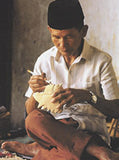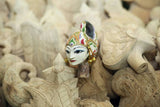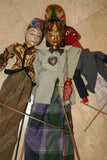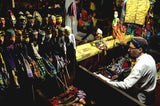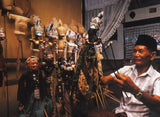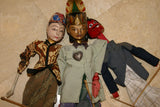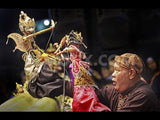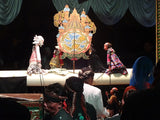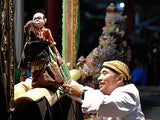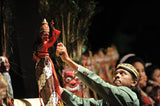Choice between 3 Old Javanese Theater Hand Carved Hand Painted Wooden Wayang Golek, Collector Puppet Dolls, King Rama, Courtesan or Prankster, or all. Yogyakarta, late 1900’s, Indonesia.
This is a choice between 3 wooden handmade older puppets, Wayang Golek collectibles, unless you want all 3. They have been used so please inspect carefully to be satisfied about the condition which is not brand new of course, but nice and operational. The middle puppet has some markings on its shirt from when it was used.
3 hand crafted Ramayana epic dolls, all vintage, 30 yrs old or older collected on the premises in Yogyakarta a long time ago.
Number 4: male courtesan, which normal retail alone is $195.00 is on the left.
Number 5: King Rama with a silver heart broach is in the center. He is disguised in peasant clothes to trick some prangsters but his crown and jewelry tells all.
Number 6: Red faced Prangster puppet on the right. The prangsters, jokers are extremely collectible. Evil characters like the demon king, Rahwana, are red or yellow, with fangs and bulging eyes such as this articulated wooden doll.
Java all male traditional Theater Puppets, Wayang Goleks once used in village plays recounting the Ramayana and the Mahabaratha epic tales.
They are being sold at a discounted price as we have very few puppets left for sale, less than 10, all collected 30 years ago, and looking to close that inventory. These entirely handcrafted Javanese traditional puppets are of characters from the amazing Ramayana tales. Around 24” tall from top of head to end of stick or dress for 2 of them and the prangster is 16" tall.
They are important center characters in the wayang golek plays of Java. The Wayang Golek face and body are made of wood and they are dressed in traditional clothing.
Each Wayang Golek puppet was individually hand carved and hand painted by the artist who created it, so each is unique and a collector item. All are operational and in good shape. The Wayang has a strong tradition in the world of Java representing the struggle between good and evil.
The Wayang Golek are the three dimensional wooden puppets from Java. The Wayang Golek plays (these shows might be given to appease the gods, to offer thanks or ask protection for a harvest, or to exorcise evil spirits) continue to be performed at circumcision or wedding parties, or at other ceremonial events and usually start at dusk and run to the early morning hours attracting an adult audience of all social classes. People come and go as they please. The Wayang Golek puppet masters are called Dalangs. The plays are based on the Ramayana or Mahabharata stories. They usually involve Rama, Sinta, Anoman, Rahwana and Gotot Kaca. The main family of Wayang Golek are the five Pandawa brothers and their clown servants. The wayang golek performance becomes a social event around which there may be many stalls selling refreshments and other small items. The audience particularly enjoys the clown scenes, when much tomfoolery and satire take place. In Indonesia, many people are familiar with the different types of characters which can be recognized by the size, shape, color and angle of their eyes and nose and the way they walk, talk, sing, dance and fight.
Puppetry is a highly respected art form in Indonesia, and continues to thrive as a vibrant living tradition, offering a coded philosophy within which there is something for everyone, rich or poor, politician or artist alike.
Wooden rod puppet characters were created in family workshops where they are chiseled, carved, painted & dressed in local costume.
The master carver makes the head because it expresses the personality of the character. Puppets are divided in 3 parts: the head and neck are connected to a sharpened bamboo piece that goes thru the separate body, enabling the puppet to turn its head left and right. From the waist down a sarong type cloth is worn hiding the puppeteer's hand that holds the bamboo piece. The joints of the articulated arms are connected with a string enabling the puppet to move his upper limbs as well. The central support rod is attached to the base of the body where it is hidden by the clothing. The women make all the batik costumes.
All our collector and rare items come with pages and pages of research about provenance, and with history of the tribes and photos as well, depending on item and whenever possible. When shipping internationally, we group ship multiple purchases to save you money, and find the best rates available. If you have any questions or want to see research conducted on this piece, let us know.
































